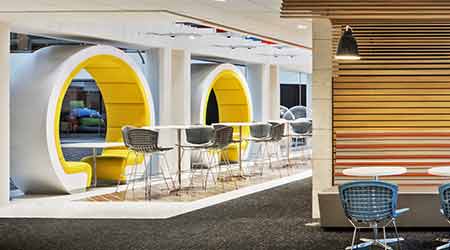 Providing purpose-driven variety at this St. Louis financial institution ensures everyone can find the right spot for their changing needs during the workday.Arch Photo Inc.
Providing purpose-driven variety at this St. Louis financial institution ensures everyone can find the right spot for their changing needs during the workday.Arch Photo Inc.Collaboration, Connection: Hallmarks Of High-Performance Office Space
You can't hack high-performance. But thoughtfulness and a clear understanding of an organization's culture and goals can result in happy, productive workers.
Everybody is searching for the golden ticket when it comes to high-performance spaces. With the right box or by following the right trend, by copying the strategy used by the famous tech company, we hope to crack the productivity code and create workspaces crackling with ingenuity.
Unfortunately, you can’t hack high-performance. High-performance commercial interiors are a concrete manifestation of a clear understanding of organizational goals and how the components of the organization interoperate to achieve those goals. Facility managers have a “fortunate and influential position,” as one industry expert puts it, as they manage the asset through which all the other entities in the organization connect and realize the goals of the enterprise. To help achieve high performance in the work environment, facility managers must understand the goals of the organization as a whole and in its parts, and ensure the space expresses and supports those goals.
No biggie, right? While there is no easy one-size-fits-all strategy, by understanding the trends in the ongoing evolution of the workplace environment and reaching out to partners within the organization, facility managers can shine as the drivers of innovation and positive change in the workplaces for which they are responsible.
Commercial interiors have embraced the concept of the open office as a high-performance strategy. Getting rid of walls and high cubicles, or perhaps cubicles all together, is believed to promote interaction and facilitate democratic access to amenities like natural light and views. With the exception of certain use types, such as law firms, open plan is what you can expect to see in a newly built commercial interior.
“The office is really becoming less and less of a workplace type,” says Elisabeth Post-Marner, principal at Spacesmith, with more than 25 years in workplace design. In addition, she says she’s seeing a greater shift to a more collegial feel. “What we’re seeing is that corporate is becoming more campus,” she says. This is marked with aspects such as lounge settings and training rooms accommodating groups up to 100, aimed at retaining the Millennial demographic, which is famous for a quick turnover rate and an appetite for engagement and continuous education.
Related Topics:
















